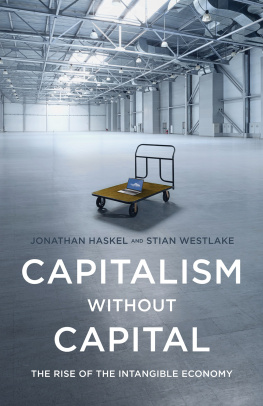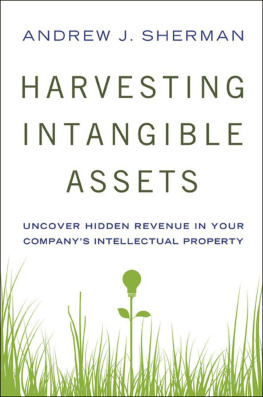CAPITALISM
WITHOUT
CAPITAL
CAPITALISM
WITHOUT
CAPITAL
THE RISE OF THE INTANGIBLE ECONOMY
Jonathan Haskel and Stian Westlake
WITH A NEW PREFACE BY THE AUTHORS
PRINCETON UNIVERSITY PRESS
Princeton & Oxford
Copyright 2018 by Princeton University Press
Preface to the paperback edition, copyright 2018 by Princeton University Press
Published by Princeton University Press, 41 William Street,
Princeton, New Jersey 08540
In the United Kingdom: Princeton University Press, 6 Oxford Street
Woodstock, Oxfordshire OX20 1TR
press.princeton.edu
Cover images courtesy of iStock
All Rights Reserved
Second printing, and first paperback printing, 2018
Paper ISBN 978-0-691-18329-9
Cloth ISBN 978-0-691-17503-4
Library of Congress Control Number: 2018943051
British Library Cataloging-in-Publication Data is available
This book has been composed in Berling LT Std
and Gotham
Printed on acid-free paper.
Printed in the United States of America
3 5 7 9 10 8 6 4 2
ILLUSTRATIONS

ACKNOWLEDGMENTS

This book would be impossible without the years of determined and insightful work by economists and others who glimpsed the beginnings of the intangible economy and sought to understand and to measure it. From the very start, Carol Corrado, Chuck Hulten, and Dan Sichel have been extraordinarily open and generous with their time and advice and have become delightful coauthors and friends. In particular, Carol Corrado has made detailed and invaluable comments on this text.
It is a pleasure as well to thank our various close coauthors over the years, as much of the data and thinking in this book is drawn from our joint work. Particular thanks are due to Tony Clayton of the Office for National Statistics and UK Intellectual Property Office, Peter Goodridge (Imperial College), Massimiliano Iommi (ISTAT), Cecilia Jona-Lasinio (LUISS), Gavin Wallis (Bank of England), Albert Bravo Biosca (Nesta), Mariela Dal Borgo (Warwick), Peter Gratzke (Nesta), Brian MacAulay (Nesta), Martin Brassell (Inngot), Ben Reid (Nesta), and Mauro Giorgio Marrano (Queen Mary).
We are also grateful to the organizations that have funded this work, including the Engineering and Physical Sciences Research Council (EPSRC, EP/K039504/1), the European Commission Seventh Framework Programme (COINVEST, 217512; SPINTAN 612774), HM Treasury, and the Agensi Inovasi Malaysia. In particular, much of the cross-country data in this book comes from the COINVEST- and SPINTAN-funded projects with long-standing coauthors Carol Corrado, Massimiliano Iommi, and Cecilia Jona-Lasinio.
Our authorial partnership began with our collaboration on Nestas Innovation Index, a project that would not have happened without the support of Richard Halkett and Jonathan Kestenbaum of Nesta, John Kingman of HM Treasury, and David Currie, who chaired the advisory board. A commission from Ryan Avent of the Economist gave us the idea of writing something for a wider audience.
We are also grateful to the people who challenged us to think about the broader implications of intangibles for the economy and for society and who patiently commented on drafts. Particular thanks go to Diane Coyle, for her insightful advice and comments throughout the project, and to Alex Edmans, Fernando Galindo Rueda, Neil Lee, Mike Lynch, David Pitt Watson, and Giles Wilkes, who commented on particular chapters, and Simon Haskel, who read the text in its entirety. Other readers and discussants to whom we are very grateful include Hasan Bakhshi, Daniel Finkelstein, Tom Forth, John Kay, Juan Mateos Garcia, Ramana Nanda, Paul Nightingale, Robert Peston, and Bart van Ark. Jonathan thanks his students Hussam Bakkar, Viktor Bertilsson, Shi The, and Xiaoyi Wang, while Stian thanks Nestas Policy & Research team for their input and support.
Of course, all errors and omissions are our responsibility.
Stians participation in the project was enabled by a period of leave from Nesta, which would not have been possible but for Geoff Mulgan, who generously granted it, and Louise Marston, who led the team with flair in his absence. Jonathan is grateful for the support of Imperial College and the European Commission-funded SPINTAN project during the writing period. All the while, Gemima King of Nesta and Donna Sutherland Smith of Imperial helped keep the show on the road.
Princeton University Press has been a source of support and encouragement throughout; we are especially grateful to Sarah Caro, Hannah Paul, and Chris Van Horne for their hard work.
Above all, we are grateful to our families for their boundless support and encouragement throughout this project: Stian to Kirsten, Aurelia, and Clara and Jonathan to Sue, Hannah, and Sarah. We dedicate this book, with love, to them.
PREFACE TO THE PAPERBACK EDITION

We had we had just marked up the final, hard-copy proofs of the book and had taken them to a FedEx office in London to have them sent to the publisher in the United States. We sealed the manuscript in the FedEx envelope and started filling out the waybill: address, sender, nature of contents, and so on, until we came to the question value of consignment.
Unsure of the exact value of our package, we left that question unanswered. You cant say zero, said the FedEx clerk. US Customs might think thats weird and hold up the delivery. What is it youre sending?
A printout of our book, we said.
The clerk picked it up. Pretty heavy block of paper, he said. Ill put down 5.
It couldnt have been more ironic that here we were, puzzling over the relationship between a pile of paper and an intangible assetthe ideas in a bookand having trouble valuing it. It was a reminder that often you can appreciate things fully only when you experience them.
Our learning process continued after the hardback version of the book was published. Tyler Cowen of Marginal Revolution developed our ideas of how intangible investment could lead to secular stagnation, and expressed them with more clarity than we managed. Similarly, the Times Danny Finkelstein and Financial Timess Martin Wolf gave us new ways to communicate our four Ss framework for the economics of intangibles. The Economists Buttonwood columnist pointed out that the rise of intangible-based companies might radically change equity markets, creating a small elite of outperforming stocks, and Chris Dillow of the Investors Chronicle worked through some of the implications for investors.
At talks at Nesta, Google, and the Conference Board, people raised with us the idea that blockchain technology could help manage the spillovers of intangibles and lay the foundations for new economic growth. Speaking to public policymakers at the UKs Treasury and 10 Downing Street, at the OECD, and in Washington pushed us to think about the consequences of intangibles for governments.











